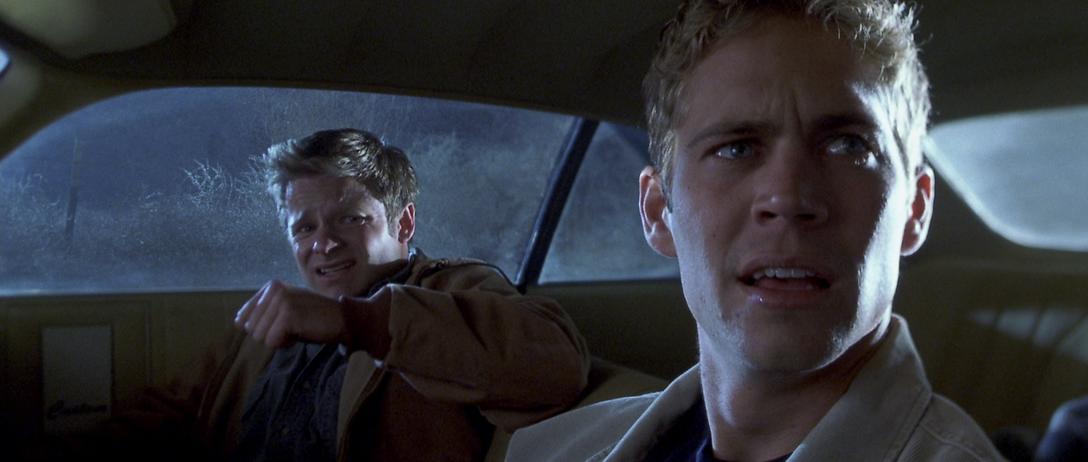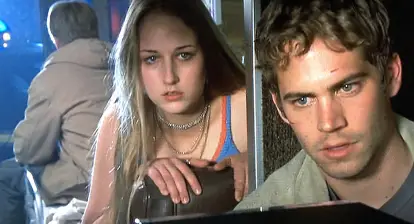Back in 2001, Paul Walker and Ted Levine starred opposite each other in a movie all about fast cars, nefarious schemes, and unchecked machismo. Joy Ride was not that film, but it was released just four months after its more famous vehicular-based counterpart, The Fast and the Furious, in which Levine plays the strict superior of Walker’s on-the-edge FBI agent. The two actors technically never share the screen in John Dahl’s film, since Levine’s terrifying trucker, Rusty Nail, is glimpsed only in passing and even then, he’s played by an entirely different actor (Matthew Kimbrough). However, Levine’s legendary voice, which first chilled our blood in The Silence of the Lambs, does all the work. As a result, for much of Joy Ride, which was co-written by none other than J.J. Abrams – whose production company backed it and whose iconic TV show Lost debuted just a month previous – we end up, as Leelee Sobieski’s character so succinctly puts it, totally scared of a radio.
See Also: V/H/S/94 is Neither Brilliant Nor Terrible [Review]
Known as Road Kill in Europe since, allegedly, we didn’t know what joyriding was (or correct spelling, for that matter), Dahl’s movie spawned several sequels of rapidly diminishing quality. Given how ruthlessly simple the original premise is, it’s shocking they managed to screw up the mythology so badly. However, without Walker and especially Levine, any future movies were arguably destined to fail. As brothers Lewis and Fuller, the Fast and Furious star and Steve Zahn make for a surprisingly great double act. Nobody does bug-eyed scared better than Zahn, but Fuller isn’t purely comic relief; there’s a darkness to him that’s fleshed out in the various hints at the duo’s tough upbringing that are sprinkled throughout. The overarching journey of the film ultimately brings them closer together as brothers, but their relationship is strained for much of the movie, especially considering it’s Fuller’s fault they run afoul of Rusty Nail in the first place. He’s got an answer for everything, but Fuller notably bolts the motel room door regardless of whether he’s professing not to be frightened.
Walker is at his laid-back Californian best here, but Lewis has less of a clue about life than F&F’s tortured Brian O’Connor. He’s looking to impress a woman by driving across country to pick her up, but Lewis has some of his big bro’s impulsiveness too, which drives him to pick up Fuller in the first place, as well as going along with the prank that will seal their fate. Walker and Zahn play well off each other, whether they’re bantering in the car, fighting over Sobieski’s Venna, or fighting for their lives. Bucking horror convention, they immediately come clean about what they’ve done to the authorities (one of whom was meant to be played by the great Walton Goggins, whose scenes were cut). Of course, it doesn’t help matters because this is still a horror movie. Also bucking convention is the character of Venna. Neither dumb, a prize to be won nor a damsel in distress, Venna is definitely third in line in matter of importance, but she’s still a fully formed character in her own right (if only she got to wear a bra, too). When Venna is captured and tied up, it’s one of the film’s darkest and most skin-crawling sequences, each scrape of the clingfilm sound-tracked by her whimpering.

Joy Ride is loaded with swearing but the violence is mostly PG-13, save for the pipe-through-the-leg moment, which is the only gore in the whole movie. For the most part, Dahl is more interested in building nail-biting tension rather than crafting all-out scares. The most frightening moments of the film are also its quietest, the two words “your taillight” cutting like a knife through skin. Likewise, the reveal of the missing jaw is brilliantly done, all slow buildup before a truly horrifying reveal with the cop’s bizarre use of the non-word “refreshify” initially throwing us off the scent. Motels are scary in general, and trucks too, but there’s something about feeling the safety of a car while also being keenly aware of how exposed they are out there in the dark that makes Joy Ride timelessly terrifying. There’s mention of a “prehistoric internet” and payphone use features heavily throughout, but the lack of technology doesn’t date the movie the way you’d expect. If anything, this kind of scenario could’ve happened any time, though it’s easier to suspend your disbelief when nobody has a cellphone.
The road stuff is shot well, giving a real sense of scale, while trucks constantly dart back and forth past the central car as though Lewis and Fuller are swimming in shark-infested waters. When Rusty Nail finally corners them, his truck backs up like a predatory animal ready to pounce, revving with smoke shooting out like a bull spoiling for a fight. Levine’s unmistakable timber is what makes Rusty Nail a formidable villain, but his massive truck is cleverly utilized to show just how out of their depth the protagonists are – particularly when it busts straight through another truck and pins their car up against a tree. A cornfield chase and grab, meanwhile, keeps us on our toes by playing with when he’s going to get out and start wandering around. It bears repeating – for most of Joy Ride, Rusty Nail is simply a voice. It’s all very low-stakes stuff, but highly impactful as the tension gradually builds.
The score, by Scream stalwart Marco Beltrami, raises the stakes considerably by mimicking the feel of a late-nineties thriller where dodgy motel rooms would’ve been the prime location. During the inciting sequence where Rusty Nail shows up at the room next door, everything is bathed in sickly green while a storm rages outside. It’s the kind of look Saw would eventually claim as its own, but here the color scheme is used to signify how safe Fuller and Lewis mistakenly feel they are. Reds and greens are utilized throughout the movie, signaling the stop/go of traffic lights as well as the danger/safe inherent in those moments, too. The lights on the transistor radio are also red and green and, again, it’s remarkable Joy Ride manages to build so much tension from this device alone, particularly considering it’s one most viewers won’t even be familiar with, especially nowadays. And yet, when Fuller arrogantly argues he can just make Rusty Nail go away by switching it off, he’s almost immediately proven wrong.

The antagonist in this situation has become something of a running joke in the intervening years thanks to the repetition of the admittedly silly words “candy cane,” but Levine is an intimidating presence, even when he’s not technically onscreen. Rusty Nail seems sweetly insecure at first, to the point you almost feel sorry for him, and his backstory is left devilishly untapped (at least in this movie). Has he killed before, or did this prank simply push him over the edge? The fact it’s not clear either way makes Rusty Nail considerably more frightening, and unpredictable, as a villain. When he does finally show up properly (ish), the guy has filthy hands and nails, which only adds to his mystique. We barely see any more of him, however, including his face. Dahl and his writers understand that what’s barely glimpsed is far scarier than what’s shown outright. We know what Rusty Nail is capable of, and that makes him a threat, whether he’s behind the wheel of a massive truck or not.
The classic car in which Lewis and Fuller spend most of their time is lovely but also banjaxed enough to be believable as an impulse buy. There’s a dusty, low-rent quality to everything in the movie from the car itself to the motel rooms and even the roads the central trio drives down, which makes Joy Ride feel like the kind of horrible scenario that could happen even if the likelihood of being chased down by a bloodthirsty trucker is low. It builds to an exciting climax and the twist ending, one of several reportedly, but the only one in which Rusty Nail survives, has a killer twist that, with modern eyes, looks like sequel-baiting but back in 2001 was a sickening gut punch after everything that preceded it. Certain movies, and especially horror films, age because of a reliance on tech or a desire to situate themselves in a particular time and place. Joy Ride doesn’t feel like it’s 20 years old because, even without smartphones, it’s a ruthlessly simple story with strong performances and a villain who’s neither superhuman nor too easily defeated. Two decades after it was first released in theaters, we still fear the radio.





